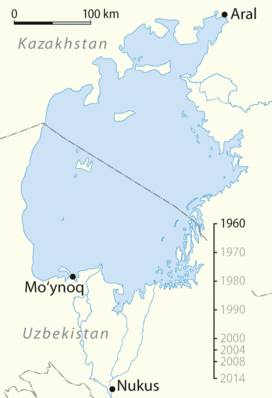Aralkum Desert facts for kids
The Aralkum Desert is a desert that formed after 1960. It appeared on the land that used to be the bottom of the Aral Sea. This desert is located to the south and east of the remaining parts of the Aral Sea. You can find it in Uzbekistan and Kazakhstan. The Aralkum Desert is currently the newest desert in the world.
Contents
History of the Aralkum Desert
The water level of the Aral Sea has changed many times over thousands of years. However, the biggest drop in its level happened after the 1960s. This was because the Soviet Union built huge irrigation systems in the area. These systems used a lot of water from the rivers that fed the Aral Sea.
Less water flowing into the sea caused its level to drop very quickly. The North Aral Sea later grew a bit thanks to a dam called the Dike Kokaral. But the South Aral Sea kept shrinking, making the desert bigger. In 2010, some parts of the South Aral Sea filled with water again. However, its water level soon started to drop even more severely.
In August 2021, a British explorer named Rosie Stancer led the first group to walk across the Aralkum desert.
Boats Left Behind
Before it became a desert, the Aral Sea was a very important place for fishing. It provided a lot of fish for the Soviet Union. As the water disappeared, many fishing boats and other vessels were left stranded. They now sit rusting in the middle of the desert.
In the city of Moʻynoq, which used to be a port, these old boats have become a popular sight for tourists. It's also where the Stihia Festival takes place. This is Central Asia's biggest electronic music festival.
Dust and Pollution
The sand and dust from the Aralkum Desert contain harmful substances. The desert is located in a place with strong winds that blow from west to east. These winds carry the polluted dust all over the world.
Dust from the Aralkum has been found far away. It has reached farms in Belarus and forests in Norway. It has even been found in the ice of Greenland. Scientists have also found chemicals from the dust in the blood of penguins in Antarctica. This shows how far the pollution can travel.
See also
 In Spanish: Aralkum para niños
In Spanish: Aralkum para niños
- Desertification
- List of environmental disasters
Images for kids




